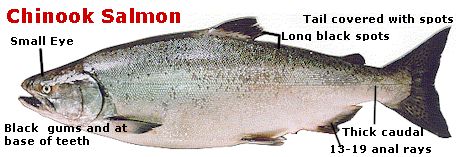
Chinook Salmon or Spring Salmon or King Salmon (Oncorhynchus tsawytscha)
Identification:
Juveniles: Parr marks oval and wider than interspaces. Adipose fin has a clear unpigmented "window". Dark spotting on both lobes of caudal fin.
Adults: Greenish-blue to black dorsal surface, often with a faint reddish hue. Numerous large, irregular black spots on the back, upper sides, dorsal fin and both lobes of the caudal fin. Gums at base of teeth in lower jaw are black. Length usually between 33 and 36 inches.

Spawning adults: Back and sides of both sexes become very dark or bright red. Upper jaw of males develops into an elongated hooked snout.
Life History: All anadromous. Two behavioural forms to life history exist. One form, found at more northern regions, spend one or more years as fry or parr in fresh water before migrating to sea. These return to the natal river in the spring or summer, several months prior to spawning. The second form is found at more southern regions, and these fish migrate to sea during their first year of life, usually within three months of emergence from the spawning gravel. They then spend most of their ocean life in coastal waters, and return to their natal river in the fall, a few days or weeks before spawning. Chinook may return to the home river mouth almost year round, however there is usually one to three peaks of migratory activity for each river system, for example, northern river systems usually peak during June, but migration may extend from April to August. Further south, runs tend to occur progressively later. Timing for the actual spawning is also variable, with northern populations spawning from July to September, and southern populations spawning from November to January. The female chooses the nest site, which is again variable, however it is always over gravel. Fecundity varies from less than 2 000 eggs per female to more than 17 000. Both females and males die after completion of spawning.
Feeding: Fresh water juveniles feed on insects, crustaceans and arachnids. Marine adults prey mainly on other fishes, also on invertebrates such as squids and crustaceans.
References:
http://www.ubcpress.ubc.ca/search/title_book.asp?BookID=1217
Groot, C and Margolis, L. Eds. 1991. Pacific Salmon Life Histories. UBC Press. Vancouver, B.C.
http://www.pskf.ca/publications/Handbook.pdf
Juvenile fish id key. 1995. The Streamkeepers Handbook: a Practical Guide to Stream and Wetland Care. Community Involvement Division, Salmonid Enhancement Program, Department of Fisheries and Oceans. Vancouver, B.C.
Scott, W and Crossman, E. 1973. Freshwater Fishes of Canada. Fisheries Research Board of Canada. Bulletin 184. Ottawa, Ontario.
© 2009 Veins of Life Watershed Society / All Rights Reserved / if you wish to use any info for commercial or non commercial usage you must obtain permissions from The Veins of Life Watershed Society